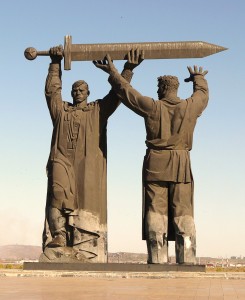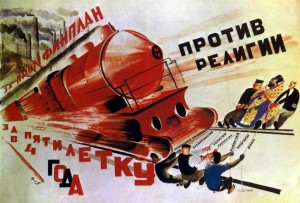The onset of Stalin’s five-year plan in 1930 spelled disaster for peasants living in the countryside of Soviet Russia. Agricultural collectivization forced many peasants on to mass collective farms where they worked for little to no return, and organized “dekulakization” was decreed by the center in 1931. Dekulakization was meant to oust the kulaks, or well-off peasants, and was carried out through executions or deportations to mass construction sites. ((Stephen Kotkin. “Peopling Magnitostroi.” Chap. 4, In Social Dimensions of Soviet Industrialization, edited by William G. Rosenberg and Lewis H. Siegelbaum, 63. Indianapolis: Indiana University, 1993, 70.)) These sites popped up around the Soviet Union, one of the largest was a city known as Magnitostroi. Stephen Kotkin details the development of a barren wasteland into a city of 200,000 in his “Peopling Magnitostroi.”
Kotkin introduces Magnitostroi as more than an industrial center; he asserts it was a “political device,” which the Bolsheviks hoped to fill with a socialist proletariat. ((Kotkin, 64.)) The site started as an isolated, bare patch of land in the southern steppe, it had few if any natural resources and no nearby cities. ((Kotkin, 64.)) The soviet center attempted multiple tactics to populate the city; army regiments, political and industrial workers, and graduates of higher education were mobilized to the city on a party member’s whim, but many did not make it. ((Kotkin, 65.)) Recruitment of ordinary soviet citizens through propaganda was also pursued. Deals with heads of factories and collective farms garnered a promise of new labor for the construction site, but far fewer bodies than what was agreed upon were sent. ((Kotkin, 69.)) Chronic labor shortages plagued Magnitostroi and the Central Committee solved this problem by deporting thousands of Kulaks to the work site. ((Kotkin, 70.)) The purported shining symbol of socialism became a dumping ground for the exiled.
Magnitostroi was meant to become an efficient capital of industry in which a proletariat diligently labored for the good of their socialist republic. This image was bastardized by brutal tactics employed to accomplish the soviet center’s goals through any means necessary. Many of the peasants who migrated to Magnitostroi came with village groups known as “artels,” in which one held power and the others remained obedient. Each artel divided wages amongst themselves as they saw fit, a collective concept which should have been looked fondly upon by socialists. Despite the supposed overlap of ideology, Bolshevik leaders took measures to “smash” what was seen as a competitor to their ultimate authority. ((Kotkin, 77.)) The Bolsheviks would compromise their ideals further by adopting the formerly Tsarist internal passport system in 1932. ((Kotkin, 86.))The system was meant to establish order and slow the rapid departure of a majority of Magnitostroi’s work force, but the policing system lacked the necessary manpower and the result was an extensive underground market for counterfeit documents. ((Kotkin, 87.)) Abuses of power and subjugation of Bolshevik ideals were performed under the guise of “defending the revolution” ((Kotkin, 86.)) and Magnitostroi became a shining example of nothing more than oppressive population management by the Bolshevik regime.
Picture from: http://1.bp.blogspot.com/-QnMOCkSBM7w/T4XvC1JEWLI/AAAAAAAAAbE/4523QPaBRTo/s1600/P1040299.JPG


